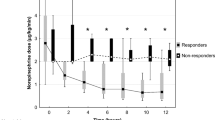Abstract
Introduction
The purpose of this study is to describe a case where methylene blue improved hemodynamics in a poisoned patient.
Case Report
This is a single case report where a poisoned patient developed vasodilatory shock following ingestion of atenolol, amlodipine, and valsartan. Shock persisted after multiple therapies including vasopressors, high-dose insulin, hemodialysis, and 20% intravenous fat emulsion. Methylene blue (2 mg/kg IV over 30 min) was administered in the ICU with temporal improvement as measured by pulmonary artery catheter hemodynamic data pre- and post-methylene blue administration. Within 1 h of methylene blue administration, systemic vascular resistance improved (240 dyn s/cm5 increased to 1204 dyn s/cm5), and vasopressor requirements decreased with maintenance of mean arterial pressure 60 mmHg.
Discussion
Methylene blue may improve hemodynamics in drug-induced vasodilatory shock and should be considered in critically ill patients poisoned with vasodilatory medications refractory to standard therapies.

Similar content being viewed by others
References
Schoffstall JM, Spivey WH, Gambone LM, Shaw RP, Sit SP. Effects of calcium channel blocker overdose-induced toxicity in the conscious dog. Ann Emerg Med. 1991;20:1104–8.
Prasa D, Hoffmann-Walbeck P, Barth S, Stedtler U, Ceschi A, Färber E, et al. Angiotensin II antagonists—an assessment of their acute toxicity. Clin Toxicol Phila Pa. 2013;51:429–34.
Smith SW, Ferguson KL, Hoffman RS, Nelson LS, Greller HA. Prolonged severe hypotension following combined amlodipine and valsartan ingestion. Clin Toxicol. 2008;46:470–4.
Yiu P, Robin J, Pattison CW. Reversal of refractory hypotension with single-dose methylene blue after coronary artery bypass surgery. J Thorac Cardiovasc Surg. 1999;118:195–6.
Preiser J-C, Lejeune P, Roman A, Carlier E, De Backer D, Leeman M, et al. Methylene blue administration in septic shock: a clinical trial. Crit Care Med. 1995;23:259–64.
Cheng X, Pang CC. Pressor and vasoconstrictor effects of methylene blue in endotoxaemic rats. Naunyn Schmiedebergs Arch Pharmacol. 1998;357:648–53.
Daemen-Gubbels CR, Groeneveld PH, Groeneveld AB, van Kamp GJ, Bronsveld W, Thijs LG. Methylene blue increases myocardial function in septic shock. Crit Care Med. 1995;23:1363–70.
Jang DH, Nelson LS, Hoffman RS. Methylene blue in the treatment of refractory shock from an amlodipine overdose. Ann Emerg Med. 2011;58:565–7.
Fisher J, Taori G, Braitberg G, Graudins A. Methylene blue used in the treatment of refractory shock resulting from drug poisoning. Clin Toxicol Phila Pa. 2014;52:63–5.
Aggarwal N, Kupfer Y, Seneviratne C, Tessler S. Methylene blue reverses recalcitrant shock in β-blocker and calcium channel blocker overdose. BMJ Case Rep. 2013;2013. doi: 10.1136/bcr-2012-007402.
Jang DH, Donovan S, Nelson LS, Bania TC, Hoffman RS, Chu J. Efficacy of methylene blue in an experimental model of calcium channel blocker-induced shock. Ann Emerg Med. 2015;65:410–5.
Nabbi R, Riess ML, Woehlck HJ. Angiotensin-receptor-blocker-induced refractory hypotension responds to methylene blue. Acta Anaesthesiol Scand. 2012;56:933–4.
Mowry JB, Spyker DA, Cantilena LR, McMillan N, Ford M. 2013 Annual Report of the American Association of Poison Control Centers’ National Poison Data System (NPDS): 31st Annual Report. Clin Toxicol Phila Pa. 2014;52:1032–283.
Andrawis NS, Craft N, Abernethy DR. Calcium antagonists block angiotensin II-mediated vasoconstriction in humans: comparison with their effect on phenylephrine-induced vasoconstriction. J Pharmacol Exp Ther. 1992;261:879–84.
Andresen M, Dougnac A, Díaz O, Hernández G, Castillo L, Bugedo G, et al. Use of methylene blue in patients with refractory septic shock: impact on hemodynamics and gas exchange. J Crit Care. 1998;13:164–8.
Kwok ESH, Howes D. Use of methylene blue in sepsis: a systematic review. J Intensive Care Med. 2006;21:359–63.
Pasin L, Umbrello M, Greco T, Zambon M, Pappalardo F, Crivellari M, et al. Methylene blue as a vasopressor: a meta-analysis of randomised trials. Crit. Care Resusc. J. Australas. Acad Crit Care Med. 2013;15:42–8.
Lenasi H, Kohlstedt K, Fichtlscherer B, Mülsch A, Busse R, Fleming I. Amlodipine activates the endothelial nitric oxide synthase by altering phosphorylation on Ser1177 and Thr495. Cardiovasc Res. 2003;59:844–53.
Zhang X, Hintze TH. Amlodipine releases nitric oxide from canine coronary microvessels an unexpected mechanism of action of a calcium channel-blocking agent. Circulation. 1998;97:576–80.
Allegaert K, Miserez M, Lerut T, Naulaers G, Vanhole C, Devlieger H. Methemoglobinemia and hemolysis after enteral administration of methylene blue in a preterm infant: relevance for pediatric surgeons. J Pediatr Surg. 2004;39:E35–7.
Albert M, Lessin MS, Gilchrist BF. Methylene blue: dangerous dye for neonates. J Pediatr Surg. 2003;38:1244–5.
Blass N, Fung D. Dyed but not dead—methylene blue overdose. Anesthesiology. 1976;45:458–9.
Paciullo CA, McMahon Horner D, Hatton KW, Flynn JD. Methylene blue for the treatment of septic shock. Pharmacotherapy. 2010;30:702–15.
Foltz LM, Dalal BI, Wadsworth LD, Broady R, Chi K, Eisenhauer E, et al. Recognition and management of methemoglobinemia and hemolysis in a G6PD-deficient patient on experimental anticancer drug Triapine. Am J Hematol. 2006;81:210–1.
Brewer GJ. Rediscovery of the susceptibility of G6PD deficient persons to methemoglobinemia from oxidant drugs, and to hemolysis from methylene blue. Am J Hematol. 2007;82:87–8.
Gillman PK. Methylene blue implicated in potentially fatal serotonin toxicity. Anaesthesia. 2006;61:1013–4.
Gillman PK. Methylene blue and serotonin toxicity: definite causal link. Psychosomatics. 2010;51:448–9.
Conflict of Interest
The authors declare that they have no competing interests.
Author information
Authors and Affiliations
Corresponding author
Rights and permissions
About this article
Cite this article
Laes, J.R., Williams, D.M. & Cole, J.B. Improvement in Hemodynamics After Methylene Blue Administration in Drug-Induced Vasodilatory Shock: A Case Report. J. Med. Toxicol. 11, 460–463 (2015). https://doi.org/10.1007/s13181-015-0500-1
Published:
Issue Date:
DOI: https://doi.org/10.1007/s13181-015-0500-1




